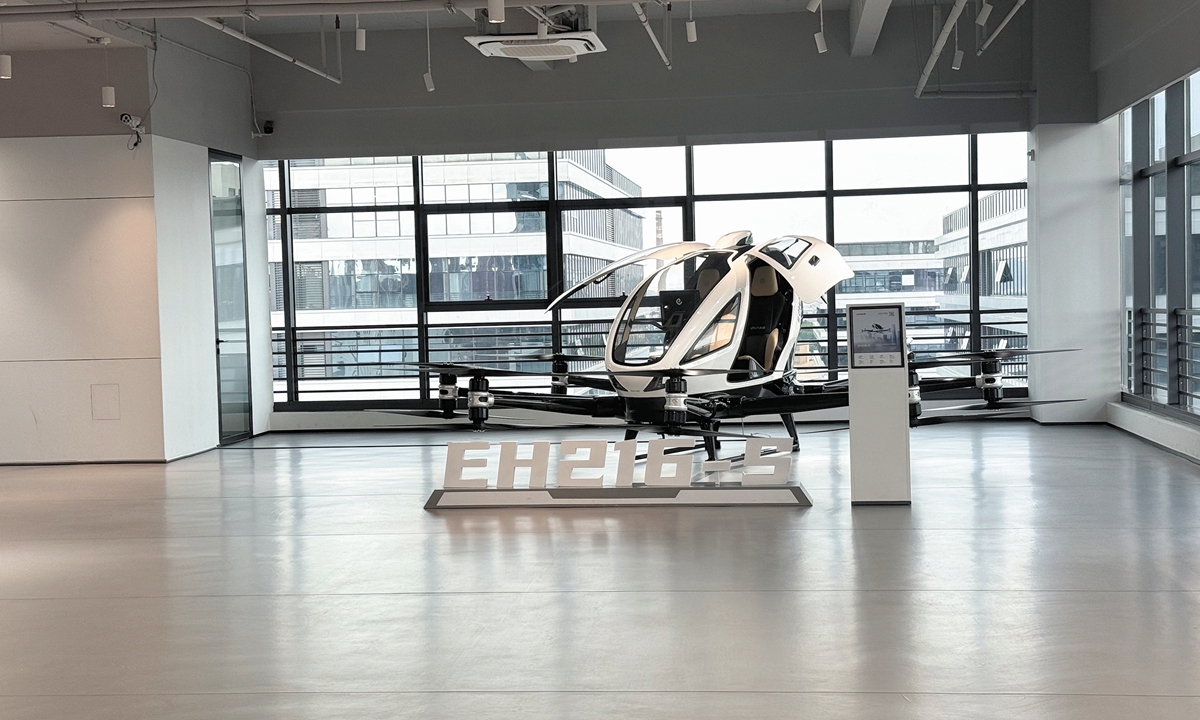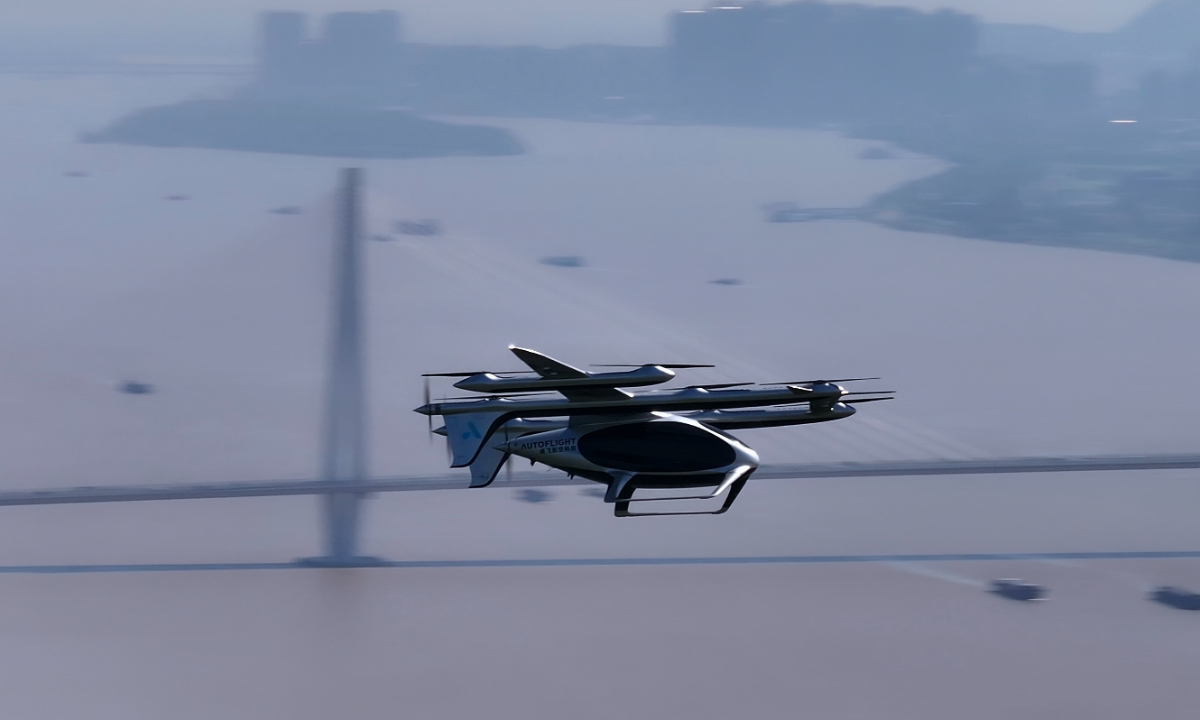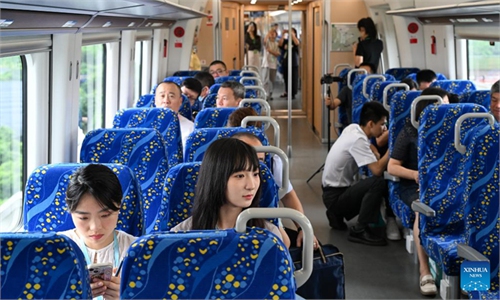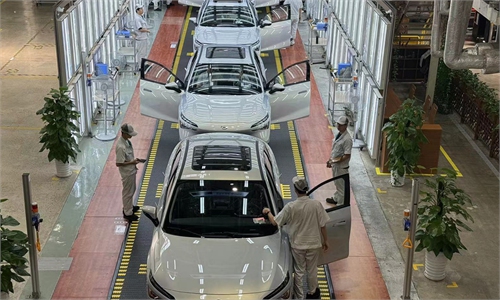Low-altitude economy takes off, as eVTOL aircraft producers tap growing demand in Greater Bay Area

An electric vertical takeoff and landing aircraft is displayed at the EHang Holding in Guangzhou, South China's Guangdong Province on July 18, 2024. Photo: Tu Lei/GT
As an important player in the low-altitude economy, China has made significant breakthroughs in the field of electric vertical take-off and landing (eVTOL) aircraft lately. Companies are showing their strength and new eVTOLs have conducted flights at home and abroad.
In a recent story published by Time titled "The Real Future of Flying Cars," it said that "China today accounts for some 50 percent of the world's eVTOL models." So, how far are we from the arrival of the "flying car" era?
When Global Times reporters looked at an eVTOL aircraft at Guangzhou-based EHang Holdings, a Chinese urban air mobility technology company, the first impression is that it looks like a modern helicopter. Except for a large screen showing information about the aircraft and a map, there seem to be no additional instruments, indicating its simplicity and maneuverability.
The company obtained a production certificate for its EH216-S eVTOL aircraft from the Civil Aviation Administration of China, a first in the world, in April.
So far, the EH216-S has obtained three key airworthiness certificates: Type Certificate (TC), Standard Airworthiness Certificate (AC) and Production Certificate (PC), indicating that it is ready for mass production. According to data from the company, the maximum speed of the model is 130km/h, the maximum range is 30 kilometers, and the maximum flight time is 25 minutes.
The certificates show that its safety has been proven, He Tianxing, vice president of EHang Holdings told the Global Times.
"Our aircraft uses a multi-redundant backup technology solution, which means when one of the components fails, the backup can take over," He added.
The Global Times also saw a new generation VT-30 aircraft, which is larger than the EH216-S, in the EHang exhibition hall. The model is mainly intended for long-distance inter-city flights, with a designed range of up to 300 kilometers and a flight time of 100 minutes.
The low-altitude economy was defined as a strategic emerging industry at the country's annual central economic work conference in 2023 and was named as a new growth engine in this year's government work report.
The domestic eVTOL industry is already booming. Products from different companies use different technology paths, with variety in terms of shape, size and passenger capacity.
In February this year, AutoFlight, a domestic pioneer in eVTOL aircraft, conducted what it says was the world's first inter-city electric air-taxi demonstration flight in South China's Guangdong Province. It shortened what would be a three-hour journey on the ground to just 20 minutes.
"Our products are all independently developed," Xie Jia, senior vice president of AutoFlight, told the Global Times. Compared with other international companies' products, domestic eVTOL aircraft can rely on a more mature industrial chain, which helps cut costs, he added.
When asked what stage the global eVTOL industry has reached at present, Zhou Yuzhe, from the China Center for Information Industry Development, told the Global Times that the global eVTOL industry is in a stage of rapid development.
The eVTOL technology route is gradually becoming clear, the market is growing rapidly, and the financing scale continues to grow, he said.
He said that there are advantages for China's eVTOL sector in terms of the component industry chain, charging infrastructure, and the aviation manufacturing industry.
Although domestically produced eVTOL aircraft have not yet entered the commercial operation stage, companies have already received quite a number of overseas orders.
He from EHang Holdings said that they have received many eVTOL orders and pre-orders from customers in Saudi Arabia, Indonesia, Malaysia, Japan, South Korea and other countries. The main application scenarios include serving as a new mode of aerial manned transportation, providing aerial sightseeing tours and emergency rescue.
In March this year, AutoFlight said it had delivered its first eVTOL aircraft to a customer in Japan. Xie also said that the company has many customers in South Korea, Southeast Asia and the Middle East.
Xie said that the company has set up an airworthiness research and development team of more than 30 people in Germany.

AutoFlight's eVTOL aircraft Prosperity commence trial flight across the Yangtze River on August 1, 2024, in Nanjing, East China's Jiangsu Province. Photo: Courtesy of AutoFlight
Chances in Greater Bay Area
Currently, many places across the country are seizing the opportunity to develop the low-altitude economy, and the Guangdong-Hong Kong-Macao Greater Bay Area has made initial explorations.
If the low-altitude economy is to form a large industrial scale, the core direction must be manned travel and logistics transportation, said He from EHang Holdings.
A number of operational models must be created in prefecture-level cities, and the cities in the Greater Bay Area have such potential, He noted.
Market analysts have said that the Greater Bay Area has a solid economic foundation, supported by an advanced manufacturing sector and first-class innovation system there. The region has many application scenarios for development of the low-altitude economy with huge potential market demand.
For example, the Greater Bay Area has brought together a number of leading companies such as DJI and EHang and cities such as Shenzhen and Guangzhou are actively creating low-altitude economic application demonstrations.
On July 4, the Greater Bay Area Low-altitude Economic Industry Alliance was officially established. The alliance will focus on improving low-altitude management services and developing low-altitude equipment manufacturing.
Members of the Legislative Council of the Hong Kong Special Administrative Region are actively promoting the formulation of relevant policies and plans for the integrated development of the low-altitude economy in the Greater Bay Area, He said.
The estimated value of the nation's low-altitude economy surpassed 500 billion yuan ($70 billion) in 2023, and is expected to quadruple by 2030, according to the Civil Aviation Administration of China (CAAC).
Data from the CAAC showed that there were 689 general aviation firms in China as of the end of 2023, with 3,173 general aviation aircraft registered and 451 general aviation airports.
For eVTOL operators such as EHang, obtaining a commercial operating license is the next target, but many barriers need to be overcome in the short term.
At present, the central and local governments are still exploring the formulation of low-altitude flight management system rules and standards. Some industry insiders believe that it is more conducive to the formation of national unified rules in the future for local governments to first implement their own air traffic rules and to create regional management models.
Manned eVTOL aircraft are expected to be operational on a small scale by 2026, and will be more widely promoted after that, said Xie from AutoFlight.




